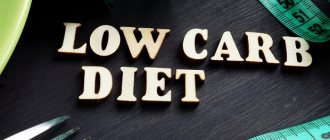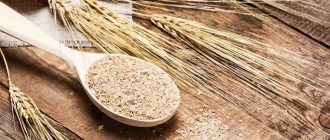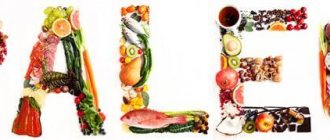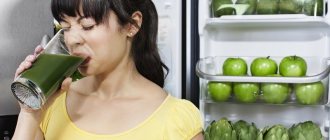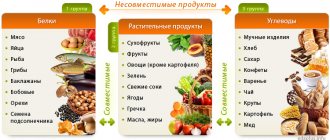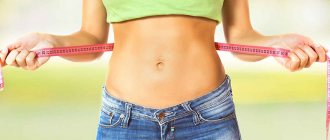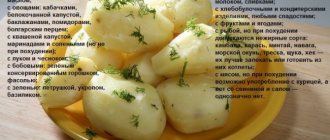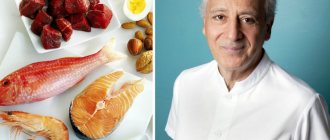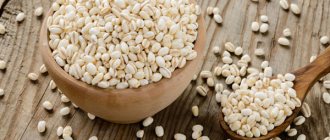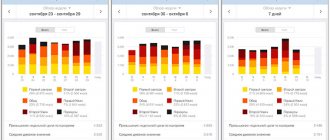© designer491 — depositphotos.com
Share:
The no-carbohydrate diet is considered the most “mild” or easily tolerated of all modern diets, despite the complete exclusion of carbohydrates from the diet. It is designed for weight loss and is truly effective in eliminating subcutaneous fat. What to eat and what not to eat on a low-carb diet? How to get out of a diet so that the lost pounds don’t come back? Read about it in our article.
Basic diet rules
This program was developed specifically for bodybuilders participating in competitions and championships, but, like many other nutrition systems, it went beyond the framework of professional sports.
Protein foods and a small amount of vegetable fats are the main emphasis of this diet. Limiting the amount of carbohydrates, although maximum, is not complete. It is still advisable to consume 30-40 g of carbohydrates per day for normal functioning of the intestines and stomach. Excluding them completely from the diet increases the risk of developing constipation and other digestive disorders.
General principles
To ensure quick and effective results, we carefully follow all aspects of this nutrition system:
- During the day, eat small meals 5-6 times. You will have to forget about intermediate snacks.
- The norms of drinking water per day are 2-2.5 liters. Drink water before meals and half an hour after, but not at the same time.
- Eat your last meal of the day before seven or eight o'clock in the evening. If you have an unbearable feeling of hunger in the evening, deceive your stomach with a glass of water, and then go to bed.
- Take vitamin and mineral supplements.
- Reduce the amount of carbohydrates in the menu gradually: from the usual norm of 150-200 g, approach the minimum value of 20-30 grams.
- Eliminate bread, sugar, coffee, foods containing starch (potatoes, beets, corn), high-GI fruits, and processed foods from your diet; food labeled as “diet” or low-fat,” alcohol is also unacceptable.
- Of vegetable fats, only a little nuts and olive or flaxseed oil are allowed.
- Frying food is allowed, but again only with olive or linseed oil.
- Don't forget about physical activity. If you can’t bear to run or swim in the morning, console yourself with the fact that thanks to physical exercise, your skin will not sag after losing weight, and your muscles will take on a beautiful shape.
The essence of the diet
This method of nutrition is based on the principle of burning subcutaneous fat by the body itself in conditions of constant lack of energy from carbohydrates consumed in food.
Without consuming carbohydrates, those losing weight experience ketosis, a state in which the body obtains energy from the breakdown of fat cells. Ketosis is considered a physiological state, in contrast to ketoacidosis, a pathology in which the number of ketone bodies in the blood critically increases. Long-term ketoacidosis is dangerous to life and health. For this reason, people transition to ketosis gradually. It is recommended to adhere to a safe ratio: 50% proteins, 35-40% fats, and 10-15% carbohydrates.
© NinaMunha — depositphotos.com. Non-carbohydrate food pyramid
The body's response to carbohydrate withdrawal
In the first week of a new diet, no visible changes occur in the body. There is either very little weight loss or no weight loss at all. At the initial stage, the body gets used to receiving energy not from foods rich in carbohydrates, but from its own fat reserves.
Reducing carbohydrates may cause drowsiness and slight weakness. The body's reaction may also be constipation. Increasing the volume of protein foods puts a strain on the liver and kidneys. Another common reaction of the body to this diet is mild stress and even depression due to the fact that the brain receives less glucose.
Burning fat on this diet does not require intense daily workouts.
Diet stages
The body’s gradual transition to consuming energy from broken down fat cells occurs in 4 stages.
- First stage. Consuming carbohydrates only in the morning. A few hours after breakfast, the supply of glucose obtained from the morning meals will expire, and the body will begin to waste its own glycogen reserves.
- Second phase. Complete exclusion of glucose from food. Glycogen from muscle cells and the liver is used to produce energy. After 2-3 days, the body feels a constant lack of carbohydrates and begins to “look” for an alternative for energy production.
- The third stage occurs 3-4 days after the start of the diet. There is almost no glycogen in the cells of the body. Fat burning is activated, but to provide the body with energy, the body resorts to proteins. You will need to eat more protein in the first week than in subsequent weeks to compensate for the increased protein consumption.
- Fourth stage. Ketosis starts. The breakdown of fat cells to produce energy begins.
What is drying
This term came into everyday life from fitness and bodybuilding. Athletes use it to burn fat while maintaining muscle mass. Yes, the process is based on a carbohydrate-free diet, but for proper drying it is not enough to find a diet on the Internet and follow it. This is, first of all, the competent preparation of an individual program: a menu with a gradual decrease in the carbohydrate component, training and strict monitoring of health. At the end of drying, the correct exit is required.
What you should know
- Even if you dry according to all the rules, it is not at all safe. The kidneys and liver are overloaded, which provokes weakness and lethargy, exacerbation of chronic diseases, disruptions in the gastrointestinal tract, etc.
- If you do not exercise, then no fat loss will occur, it will be a regular low-calorie diet. You shouldn’t expect miracles from her, but health problems are quite expected.
- Carrying out drying makes sense only if you have previously engaged in sports training and have muscle mass that needs to be eliminated from a layer of fat. If there are no pronounced muscles under the layer of fat, it will be more effective for you to give up flour, fatty and sweet foods.
- This is a long process and is not suitable as a quick way to lose weight before going on vacation. Short-term drying (to prepare for competitions) lasts one to two weeks, and long-term (gradual) drying lasts five to seven weeks. Only gradual steps will help you tighten your figure.
- Conducted no more than twice a year.
Perfect drying
- Two weeks before the start of drying, it is necessary to support the liver. Hepatoprotectors will help you with this - preventive agents that have a positive effect on liver function. The list of such drugs includes Maxar, Heptral, Essentiale Forte, Ursofalk, etc.
- During this time, the body should not experience any stress: travel, wedding, session, emergency at work, etc. Therefore, carefully plan the drying period.
- Women are not recommended to “dry” for more than a month and a half, otherwise hormonal imbalances will follow. At the end of the process there is an exit. The duration is equal to the drying itself.
- Training during this period should be short but very intense. Cardio training should last no more than half an hour, and strength training should last 45 minutes.
- The calorie content of the diet is only 300-350 calories less than usual. A too low-calorie menu (up to 1200 kcal per day) is only suitable if before drying your weight is 55 kg or less.
- Protein shakes and other dietary supplements are used in agreement with the trainer.
Nutritionists strongly warn: cutting is not just about following a carbohydrate-free diet; it is too serious a process to do on your own, at home. Experiments can have a negative impact on health.
Types of low-carbohydrate diet
Several varieties of this nutrition program are practiced: constant, circular and power. Each of them has its own characteristics.
Power
Suitable only for professional athletes. Its essence is to take carbohydrates before training, so that you have the strength to fully work with heavy physical activity. This approach is only justified with an intensive training program. Otherwise, you will not waste the carbohydrates received in full and will not lose weight.
Constant
You consume no more than 20 grams of carbohydrates per day with fiber. The emphasis in the diet is on proteins and vegetable fats. By completely giving up carbohydrates, you risk experiencing psychomotor retardation, absent-mindedness, and decreased speed of thinking and perception.
Circular
This approach consists of reducing carbohydrate intake to 30-40 g in vegetables and cereals. The restriction lasts 6 days. On the seventh day, a full carbohydrate “load” occurs. You are allowed to eat porridge, vegetables, pasta, and a couple of fruits.
Loading starts the production of enzymes, stimulates metabolic processes and enriches muscle cells with glycogen. By practicing this approach, you will work fully, feel great, and avoid all the negative effects of eliminating carbohydrates.
Side effects
Like any diet, this nutritional method also has its negative aspects.
Among them:
- frequent constipation;
- development of kidney and liver diseases;
- avitaminosis;
- uncontrollable irritability;
- suppression of the body's immune function;
- fatigue, lethargy;
- decreased attention;
- depression of brain function.
The appearance of some side effects can be avoided with proper diet planning, additional intake of vitamins and macroelements, and monitoring the duration of the diet.
List of approved products
Allowed foods during a carbohydrate-free diet include boiled or baked fish, boiled red meat (rabbit, beef), poultry fillet boiled or in steam cutlets, dairy products with a protein content of no more than 5%.
Vegetables
Green vegetables are allowed: lettuce, cucumber, cilantro, parsley, white cabbage, dill and some fruits: sour green apples, coconut, citrus fruits, peaches.
Nuts
It is recommended to eat nuts. This is a source of fat. Several times a week, try to eat a handful of peanuts, hazelnuts and any other nuts.
Cereals
Supplement your diet with buckwheat and millet. It is allowed to eat side dishes of stewed or baked zucchini, asparagus, and eggplant.
© NinaMunha — depositphotos.com
Table of permitted products
The list of products indicated for consumption is extensive. Use it as a base for your low-carb diet. The calorie content of each type of product is indicated per 100 grams.
Table of allowed foods during a low-carbohydrate diet:
| Products | Proteins, grams | Fats, grams | Carbohydrates, grams | Calories, Kcal |
| Vegetables and greens | ||||
| eggplant | 1,2 | 0,1 | 4,5 | 24 |
| peas | 6 | – | 9 | 60 |
| zucchini | 0,6 | 0,3 | 4,6 | 24 |
| cabbage | 1,8 | 0,1 | 4,7 | 27 |
| broccoli | 3 | 0,4 | 5,2 | 28 |
| cabbage | 1,2 | 0,2 | 2 | 16 |
| cilantro | 2,1 | 0,5 | 1,9 | 23 |
| leek | 2 | – | 8,2 | 33 |
| bulb onions | 1,4 | – | 10,4 | 41 |
| cucumbers | 0,8 | 0,1 | 2,8 | 15 |
| olives | 0,8 | 10,7 | 6,3 | 115 |
| squash | 0,6 | 0,1 | 4,3 | 19 |
| sweet green pepper | 1,3 | – | 7,2 | 26 |
| parsley | 3,7 | 0,4 | 7,6 | 47 |
| radish | 1,2 | 0,1 | 3,4 | 19 |
| arugula | 2,6 | 0,7 | 2,1 | 25 |
| salad | 1,2 | 0,3 | 1,3 | 12 |
| asparagus | 1,9 | 0,1 | 3,1 | 20 |
| tomatoes | 0,6 | 0,2 | 4,2 | 20 |
| dill | 2,5 | 0,5 | 6,3 | 38 |
| garlic | 6,5 | 0,5 | 29,9 | 143 |
| lentils | 24,0 | 1,5 | 42,7 | 284 |
| Fruits | ||||
| oranges | 0,9 | 0,2 | 8,1 | 36 |
| grapefruit | 0,7 | 0,2 | 6,5 | 29 |
| lime | 0,9 | 0,1 | 3 | 16 |
| lemons | 0,9 | 0,1 | 3 | 16 |
| tangerines | 0,8 | 0,2 | 7,5 | 33 |
| peaches | 0,9 | 0,1 | 11,3 | 46 |
| pomelo | 0,6 | 0,2 | 6,7 | 32 |
| sweetie | 0,7 | 0,2 | 9 | 58 |
| apples | 0,4 | 0,4 | 9,8 | 47 |
| Nuts and dried fruits | ||||
| cashew | 25,7 | 54,1 | 13,2 | 643 |
| coconuts | 3,4 | 33,5 | 6,2 | 354 |
| almond | 18,6 | 57,7 | 16,2 | 645 |
| pistachios | 20 | 50 | 7 | 556 |
| hazelnut | 16,1 | 66,9 | 9,9 | 704 |
| Cereals and porridges | ||||
| buckwheat | 4,5 | 2,3 | 25 | 132 |
| quinoa | 14,1 | 6,1 | 57,2 | 368 |
| Dairy | ||||
| skim milk | 2 | 0,1 | 4,8 | 31 |
| kefir 1% | 2,8 | 1 | 4 | 40 |
| sour cream 10% (low-fat) | 3 | 10 | 2,9 | 115 |
| Ryazhenka 1% | 3 | 1 | 4,2 | 40 |
| natural yogurt 2% | 4,3 | 2 | 6,2 | 60 |
| Cheeses and cottage cheese | ||||
| cheese | 24,1 | 29,5 | 0,3 | 363 |
| cottage cheese 0% (low fat) | 16,5 | – | 1,3 | 71 |
| Meat products | ||||
| pork | 16 | 21,6 | – | 259 |
| pork liver | 18,8 | 3,6 | – | 108 |
| beef | 18,9 | 19,4 | – | 187 |
| beef liver | 17,4 | 3,1 | – | 98 |
| beef kidneys | 12,5 | 1,8 | – | 66 |
| beef heart | 15 | 3 | – | 87 |
| beef tongue | 13,6 | 12,1 | – | 163 |
| beef brains | 9,5 | 9,5 | – | 124 |
| veal | 19,7 | 1,2 | – | 90 |
| mutton | 15,6 | 16,3 | – | 209 |
| rabbit | 21 | 8 | – | 156 |
| venison | 19,5 | 8,5 | – | 154 |
| horsemeat | 20,2 | 7 | – | 187 |
| bacon | 23 | 45 | – | 500 |
| ham | 22,6 | 20,9 | – | 279 |
| cutlets | 16,6 | 20 | 11,8 | 282 |
| steak | 27,8 | 29,6 | 1,7 | 384 |
| pork meatballs | 7 | 10 | 12 | 172 |
| Bird | ||||
| chicken | 16 | 14 | – | 190 |
| turkey | 19,2 | 0,7 | – | 84 |
| duck | 16,5 | 61,2 | – | 346 |
| Eggs | ||||
| omelette | 9,6 | 15,4 | 1,9 | 184 |
| chicken eggs | 12,7 | 10,9 | 0,7 | 157 |
| quail eggs | 11,9 | 13,1 | 0,6 | 168 |
| Fish and seafood | ||||
| flounder | 16,5 | 1,8 | – | 83 |
| salmon | 19,8 | 6,3 | – | 142 |
| mackerel | 20,7 | 3,4 | – | 113 |
| herring | 16,3 | 10,7 | – | 161 |
| cod | 17,7 | 0,7 | – | 78 |
| tuna | 23 | 1 | – | 101 |
| trout | 19,2 | 2,1 | – | 97 |
| Oils and fats | ||||
| vegetable oil | – | 99 | – | 899 |
| Non-alcoholic drinks | ||||
| lingonberry juice | 0,1 | – | 10,7 | 41 |
| green tea | – | – | – | – |
Download the table of foods allowed on a low-carbohydrate diet here so that you always have it at your fingertips.
© JuliaMikhaylova — depositphotos.com
Diet recipes
There are a huge number of foods allowed on a hypocarbohydrate diet. This makes it possible to come up with a wide variety of tasty and healthy dishes. They are easy to prepare at home. You can use either ready-made recipes or develop them yourself. The main thing is to adhere to the basic principles:
- cook mainly by steaming or in the oven;
- Use lemon juice instead of salt as a seasoning for dishes.
Squid salad
Ingredients:
- chicken egg - 1 or 2 pieces;
- squid – 150 grams;
- canned corn – 70 grams;
- cucumber – 1 piece;
- lemon juice, olive oil
Preparation:
- Leave the boiled eggs under cold water for a few minutes. Clear.
- Cut into small pieces of any shape.
- Rinse the squid well under cold water. Place in boiling water for 3 minutes.
- Cut them and the cucumber into thin strips.
- Mix all ingredients.
- Season with lemon juice or olive oil. Mix again. Serve.
Chicken fillet stewed in a slow cooker
Used:
- chicken fillet – 260 grams;
- water – 160 milliliters;
- ground black pepper to taste;
- tomato paste – 60 milliliters;
- bay leaf - 2 pieces.
Preparation:
- Wash the meat thoroughly and remove excess moisture with a towel.
- Cut into portions, pepper and salt.
- Place in a slow cooker. Add bay leaf, paste, water.
- Mix.
- Turn on “Quenching” for 1.5 hours.
Chicken stewed in pots
Components:
- spinach – 400 grams;
- greens - a bunch;
- vegetable broth - 240 milliliters;
- chicken meat – 500 grams;
- broccoli – 300 grams;
- wine – 100 milliliters;
- onion – 1 piece;
- carrots – 2 pieces;
- apple juice – 70 milliliters.
How to cook:
- Wash and chop the vegetables. Divide the cabbage into florets.
- Cut the chicken meat into small pieces.
- Chop the greens.
- Mix. Add spices to taste.
- Juice, wine, broth are useful as a marinade.
- Place all ingredients into pots. Add marinade.
- Cover with foil.
- Place in a preheated oven (180°C). Bake for an hour.
Vegetable soup with beef meatballs
You will need:
- onion – 80 grams;
- chicken egg - 1 piece;
- bay leaf – 5 pieces;
- beef meat – 415 grams;
- pepper – 180 grams;
- cauliflower – 200 grams;
- meat seasoning - to taste;
- greens – 50 grams.
Cooking:
- Grind the beef until minced. No need to wash.
- Add the egg. Spice up. Add salt. Form into small balls
- Chop the vegetables. Chop the greens. Shred the cabbage.
- Boil water.
- Cook meatballs and other preparations for 17 minutes.
- Add greens. Serve the dish.
Vegetarian borscht
Components:
- water – 1.7 liters;
- beets - 1 piece;
- dill – 10 grams;
- onions – 1 piece;
- parsley – 10 grams;
- tomato paste – 30 grams;
- carrots - 1 piece;
- salt - 1 gram.
Cooking:
- Peel the beets and cook until soft over low heat.
- Sauté onions and carrots. Use a small amount of vegetable oil.
- Grind the beets on a coarse grater.
- Add all the ingredients to the resulting beet broth.
- Add pasta and salt after boiling water.
- When setting the table, decorate the plate with the dish with chopped herbs.
Dried chicken breasts
Products:
- chicken breast – 500 grams;
- cognac – 110 milliliters;
- salt.
Necessary:
- Rub the chicken breast with salt.
- Place in a glass container and add cognac. Cover with cling film. Place in the refrigerator for two days. Take out and stir twice a day.
- Rinse the meat. Leave in cold water for 20 minutes. Remove and dry with towels.
- Wrap the pieces of meat in a linen towel and leave in the refrigerator for two days.
- Steam the meat over the stove for 3 hours.
Oat bran soup
What to take:
- onion – 1 piece;
- chopped dill - 1.5 tablespoons;
- turkey – 170 grams;
- green bow – 3 arrows;
- chicken egg – 1 piece;
- water – 1.2 liters;
- oat bran - 300 grams;
- salt to taste.
How to cook:
- Cut the meat into small pieces. Boil in brackish water for 20 minutes.
- Add greens and onions. Smash
- Cook for 7 minutes. Add bran.
- After 15 minutes, remove from heat.
Salad with Chinese cabbage and fruits
Need to:
- head of cabbage - 1 piece;
- apple - 1 piece;
- citrus fruits or grapefruit – 1 piece;
- lemon juice – 30 milliliters;
- green onions – 10 grams;
- salt - to taste.
Process:
- Peel the orange. Cut the pulp into large slices.
- Cut the apple into cubes.
- Shred the cabbage. Add to fruit.
- Add herbs, salt. Season with lemon juice.
Meat with cheese in the oven
Required:
- feta cheese – 120 grams;
- veal – 450 grams;
- refined vegetable oil – 40 milliliters;
- milk – 110 milliliters;
- salt as desired.
Instructions:
- Rinse the meat under running cold water. Cut. Beat it off.
- Place in a mold, having previously greased it with oil.
- Salt and pepper. Pour milk.
- Place in an oven preheated to 190°C. Time: 60 minutes.
- Remove from oven. Garnish with slices of cheese.
- Return it back. Bake for another 30 minutes.
White fish with vegetables
Ingredients:
- white fish – 0.5 kilograms;
- tomato – 3 pieces;
- eggplants - 1 piece;
- salt - optional.
Actions:
- Cut the fish into small portions.
- Sprinkle with salt.
- Place on a baking sheet with vegetables.
- Bake at 180°C for an hour.
- The dish will be more appetizing in combination with eggs, salads or sauce.
Partially restricted and prohibited products
Although this nutritional program is varied and not considered too strict, you will still have to give up some foods. The first to be banned are packaged juices, fruit drinks, and sparkling water. You should not eat fresh starchy foods: potatoes, beets, carrots and corn. You should also avoid products labeled “low-calorie,” “low-fat,” “light,” or “diet.”
The strictest ban applies to alcoholic beverages and fast food, as well as all kinds of cakes, pastries and sweets from the supermarket. Also prohibited “treats” include smoked foods: sausages, smoked chicken, smoked fish. A partial ban applies to frozen foods: green frozen vegetables can be used to prepare a side dish. Flour products (bread), including homemade baked goods, are prohibited. The only exception is pasta, which needs to be cooked for longer than 5 minutes.
Table of foods that are prohibited on a low-carbohydrate diet:
| Products | Proteins, grams | Fats, grams | Carbohydrates, grams | Calories, Kcal | ||||
| Vegetables and greens | ||||||||
| corn | 3,5 | 2,8 | 15,6 | 101 | ||||
| carrot | 1,3 | 0,1 | 6,9 | 32 | ||||
| Fruits | ||||||||
| bananas | 1,5 | 0,2 | 21,8 | 95 | ||||
| persimmon | 0,5 | 0,3 | 15,2 | 66 | ||||
| Berries | ||||||||
| grape | 0,6 | 0,2 | 16,6 | 65 | ||||
| Cereals and porridges | ||||||||
| semolina | 3,0 | 3,2 | 15,3 | 98 | ||||
| white rice | 6,7 | 0,7 | 78,9 | 344 | ||||
| Flour and pasta | ||||||||
| wheat flour | 9,2 | 1,2 | 74,9 | 342 | ||||
| pasta | 10,4 | 1,1 | 69,7 | 337 | ||||
| pancakes | 6,1 | 12,3 | 26 | 233 | ||||
| vareniki | 7,6 | 2,3 | 18,7 | 155 | ||||
| dumplings | 11,9 | 12,4 | 29 | 275 | ||||
| Bakery products | ||||||||
| sliced loaf | 7,5 | 2,9 | 51 | 264 | ||||
| wheat bread | 8,1 | 1,0 | 48,8 | 242 | ||||
| Confectionery | ||||||||
| candies | 4,3 | 19,8 | 67,4 | 453 | ||||
| Raw materials and seasonings | ||||||||
| sugar | – | – | 99,6 | 398 | ||||
| Cheeses and cottage cheese | ||||||||
| curd mass with raisins | 6,8 | 21,6 | 30 | 343 | ||||
| Sausages | ||||||||
| boiled doctor's sausage | 13,7 | 22,8 | – | 260 | ||||
| Alcoholic drinks | ||||||||
| beer | 0,3 | – | 4,6 | 42 | ||||
| Non-alcoholic drinks | ||||||||
| cola | – | – | 10,4 | 42 | ||||
| energy drink | – | – | 11,3 | 45 | ||||
You can download the list of foods prohibited on a low-carbohydrate diet here. This way you will always have it at hand.
© iodrakon — depositphotos.com
Low-carbohydrate diet menu for weight loss for a week
- You can eat lamb, pork, chicken, veal, rabbit - all this, of course, within acceptable limits.
- The second mandatory product of the diet is egg whites. You can make a light salad with them, cook an omelet, or simply eat them boiled.
- Another important menu ingredient is fermented milk products. Snacks made from yogurt, kefir, and fermented baked milk will help cope with hunger between morning, lunch and evening meals.
We present to your attention a carbohydrate-free menu for seven days. Based on it, you can easily create your monthly nutrition program. Just swap the days or supplement it with products from the allowed list.
Try to drink a lot of water and consume as little salt as possible.
The menu for every day on a low-carbohydrate diet for weight loss may look like this:
| Day of the week | Daily diet |
| Monday | Morning: a glass of one percent kefir, 200 g of brown rice and a glass of unsweetened tea. Snack: a portion of boiled beets with olive oil, a couple of walnuts. Day: boiled chicken with a salad of cucumber, cabbage, onion and pepper. Snack: three boiled egg whites with a piece of hard cheese. Evening: boiled fish, one hundred grams of cottage cheese, unsweetened green tea or an apple. |
| Tuesday | Morning: a glass of plain yogurt, 4 walnuts. Snack: green apple. Day: soup with chicken and vegetables, 200 gram piece of boiled veal. Snack: a glass of one percent kefir, 2 pieces of cheese. Evening: boiled whites of 3 eggs with seafood salad. |
| Wednesday | Morning: 150-200 g boiled oatmeal Snack: grapefruit or pomelo. Day: turkey and green bean soup, a glass of low-fat kefir, 200 g of boiled turkey. Snack: Cabbage and cucumber salad with olive oil. Evening: 200 g boiled pork, 2 cucumbers and a tomato. |
| Thursday | Morning: omelette of three egg whites and 1 yolk, 2 slices of ham, unsweetened green or herbal tea. Snack: a glass of unsweetened yogurt and an apple. Day: 200 g of boiled fish and a side dish of stewed vegetables. Snack: low-fat cottage cheese 100 g. Evening: 200 g of boiled meat and the same amount of fresh vegetable salad. |
| Friday | Morning: a glass of kefir with bran, a handful of any nuts. Snack: 2 apples or peaches. Day: lamb broth, boiled lamb, vinaigrette. Snack: any vegetable salad and a couple of egg whites. Evening: 200 g of boiled fish, 100 g of cottage cheese, low-fat kefir. |
| Saturday | Morning: buckwheat porridge + a couple of prunes, a mug of coffee without sweeteners. Snack: 100 g cottage cheese with bran. Day: borscht without potatoes, 200 g of boiled meat. Snack: fresh cabbage and cucumber salad with olive oil. Evening: vegetable salad with seafood, 2 pieces of hard cheese, a glass of one percent kefir. |
| Sunday | Morning: an omelette of three proteins, a couple of pieces of boiled fish, a slice of whole grain bread and unsweetened green tea. Snack: one percent kefir. Day: 200 g beef and 100 g brown rice. Snack: low-fat cottage cheese or fresh vegetable salad. Evening: boiled chicken 200 g and buckwheat 100 g. |
Save the table of the sample menu by downloading it here so that it is always at hand.
Basic diet
Foods that can be eaten without restrictions:
- meat (beef, veal, rabbit, turkey);
- poultry eggs and offal (liver, tongue, heart);
- fish and seafood (sea fish fillets, shrimp, lobsters, crabs);
- dairy products (cottage cheese, sour cream, milk, unsweetened yogurt);
- berries, citrus fruits and other low GI fruits;
- vegetables (fresh cabbage, peas and beans, leafy greens and vegetables);
- nuts and seeds.
In general, the good thing about a carbohydrate-free way to lose weight is that you can create your own diet, based on the calorie content tables. In these tables you will also see the content of fats, proteins, and carbohydrates.
How to behave in case of a breakdown?
Even with the most varied and rich menu, breakdowns are possible when you are tempted by “goodies” at a holiday, party, or buy something from the prohibited list in the supermarket. Whether you will fail or not depends on how you view the diet: as a means that will help you become slimmer and more beautiful, or as just another “diet” test. Start your diet with a positive mindset and you will find it easier to stick to your restrictions. You will not notice how the time you are going to diet will fly by.
If you still allow yourself a sausage sandwich or fast food, but intend to continue the diet, do not scold yourself. Excessive self-criticism will only spoil the mood. Analyze the cause of the breakdown and try to avoid such situations in the future. Do not go shopping on an empty stomach and always make a list of products so as not to be tempted by various “harmful things”.
© yarunivphoto — depositphotos.com
How to get out of a low-carb diet?
Considering that this diet does not provide for strict restrictions, except for reducing carbohydrate consumption to 30-40 g per day, the concept of exiting it is conditional.
Yield refers to only a slight increase in carbohydrate intake per day. According to the recommendation of doctors, it is advisable to adhere to their reduced content in food for the rest of your life, unless there are contraindications to this due to your state of health.
The rate of carbohydrate consumption after this diet rises to 50-60 g: you smoothly transition to a constant low-carbohydrate diet.
Changes in hormonal levels
A lack of calories and carbohydrates can change the level of production of the following hormones.
- T3 is a thyroid hormone. Research Dietary-induced alterations in thyroid hormone metabolism during overnutrition. show that a strict diet can reduce hormone production, and the lack of carbohydrates affects the thyroid gland more than a macronutrient-balanced diet.
- Cortisol is a stress hormone. The absence of carbohydrates increases its production, which negatively affects the functioning of the body's main systems.
- Testosterone. According to research, a low-carbohydrate diet reduces Diet-hormone interactions: protein/carbohydrate ratio alters reciprocally the plasma levels of testosterone and cortisol and their respective binding globulins in man the production of this sex hormone.
Adviсe
Some useful tips:
- Don't worry if you haven't started losing weight after the first week of the diet. During this time, your body is just getting used to the new diet.
- In the first week, reduce your carbohydrate intake to 20 g, and in subsequent weeks, double this amount. This is necessary for ketosis to start.
- Don't fast to speed up results. This will only worsen your overall health. Meals in the morning, lunch and evening, as well as snacks are required.
- Do not try strict carbohydrate abstinence unless you are a professional athlete.
- Print out a list of foods that you can eat and carry it with you when you go to the supermarket.
Recipes for healthy eating
Baked bacon with vegetables
- 3.9 g Protein
- 15.1 g Fat
- 29.8 g Carbohydrates
- 195.2 kcal
40-50 min.
- #bacon
- #bell pepper
- #second course
- #baking
- #greenery
- #potato
- #leek
- #carrot
- #dinner
- #vegetable oil
- #spices
- #dinner
- #beans
- #garlic
Other recipes
Reviews
Below are some reviews about the no-carb diet and its results:
Photos before and after
Photos before and after a no-carb diet:
Alexandrova Anastasia
Nutrition and healthy lifestyle specialist and author of myfitnesblog.com. For many years, she has successfully helped women and men lose weight and maintain a beautiful figure.
